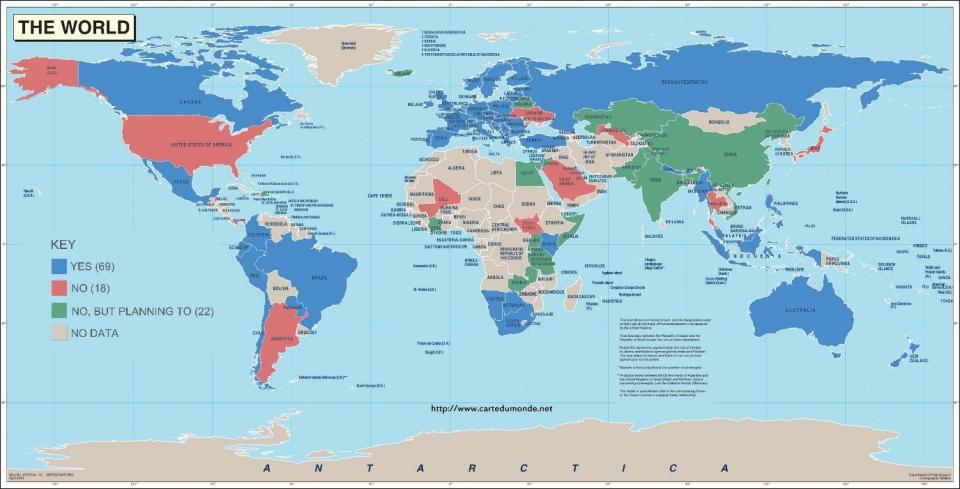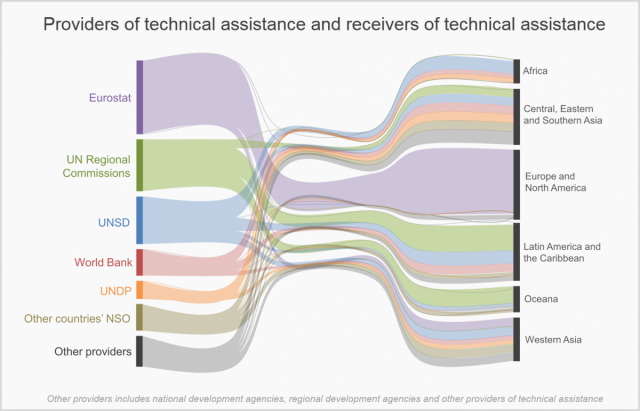Where in the World is the SEEA?

In 2015, the United Nations Committee of Experts on Environmental-Economic Accounting (UNCEEA) updated its implementation strategy to include the goal of having at least 100 countries with ongoing, well-resourced programmes in the SEEA Central Framework accounting by 2020. Two years later, how close is the UNCEEA to reaching that goal?
To assess the current status of SEEA implementation, the UNCEEA designed a Global Assessment of Environmental-Economic Accounting. The aim of the Global Assessment is to measure progress of SEEA implementation on a regular basis. The assessment serves to gain a better understanding of the current status of national SEEA implementation (including institutional arrangements), countries’ priorities and future plans for implementing accounts and countries’ needs in terms of support for implementation of the SEEA. The survey was first administered to the national statistical offices of UN Member States and additional territories in 2006. It was again administered in 2014, and the most recently, the Global Assessment was sent to national statistical offices in June 2017. The 2017 Global Assessment saw the largest number of respondents so far, with 109 countries responding to the questionnaire.
Where we are now and where we’re going
According to the results of the 2017 Global Assessment, SEEA programmes can be found in 69 countries. This is good cause for celebration, as it corresponds to a 28 per cent increase in the number of countries with a SEEA programme compared to the 2014 Global Assessment and a 41 per cent increase in the number of countries compared to the 2006 Global Assessment. The growth has been greatest in developing countries—the number of responding countries with a programme increased by 19 per cent in developed countries and 39 per cent in developing countries, compared to the 2014 Global Assessment.
The growth of the SEEA in developing countries is expected to continue. In addition to the 69 countries with programmes, 22 more countries have indicated that they are planning to start the compilation of accounts for the first time. Out of these 22 countries, 86 per cent were developing countries. In terms of the growth of SEEA in certain geographical regions, the countries planning programmes were spread around the world, attesting to the increasing popularity of environmental-economic accounting globally.
It is important to note that SEEA implementation entails both having a programme and a regular budget for repeat compilation and publication. However, it is expected that countries will implement the SEEA gradually, taking into account changing policy demands and resource requirements. Thus, not all countries with programmes have a regular budget. However, a majority of countries with programmes do have a regular budget. According to the Assessment, 45 countries with programmes also have regular funding, thus contributing to the SEEA implementation targets.
Into the details
Apart from the number of countries with programmes, what else can we learn from the 2017 Global Assessment? For starters, the assessment gives us a good picture of what accounts countries are focusing on. Overall, the most commonly compiled accounts included energy, environmental protection expenditures, material, air emission, environmental taxes and subsidies, environmental goods and service sector and water accounts. The most commonly compiled accounts varied between developed and developing countries, with developed countries focusing more on accounts such as material flow (of natural inputs, products and residuals), environmental taxes and subsidies, and air emission accounts compared to developing countries which focussed more on energy and water accounts. The next administration of the Global Assessment may paint a different picture however, as an overwhelming majority of countries with programmes (81 per cent) indicated that they planned to expand their environmental-economic accounting programme.
Both developed and developing countries cited energy, water, material, environmental protection expenditure and waste accounts as priorities. However, developed countries also indicated air emission accounts as priorities while developing countries additionally cited agriculture, forestry and fisheries and waste accounts as priorities.

Moving forward
With so many countries planning to compile accounts for the first time or expand their programmes, the next step for the UNCEEA is to use the results of the Global Assessment to coordinate countries’ needs in terms of technical assistance and other support. The 2017 Global Assessment indicated that a majority of countries with programmes received technical assistance which included a whopping 91 per cent of developing countries. Moving forward, technical assistance and support by institutions in the environmental-economic accounting space will be vital to meet the needs of the countries planning to compile accounts for the first time.
*Please note that the first figure has been modified from a United Nations map. The boundaries and names shown and the designations used on the map do not imply official endorsement or acceptance by the United Nations.
